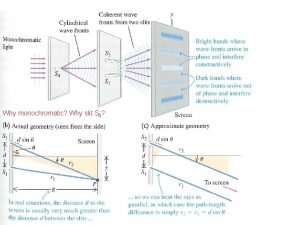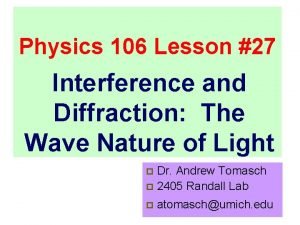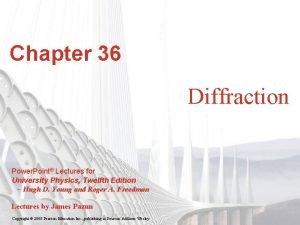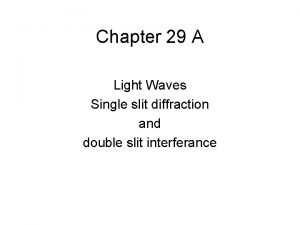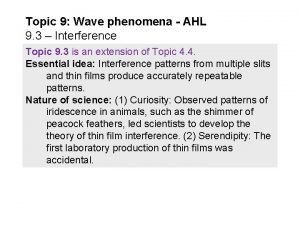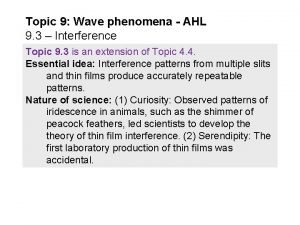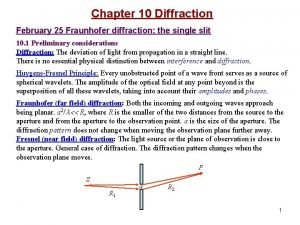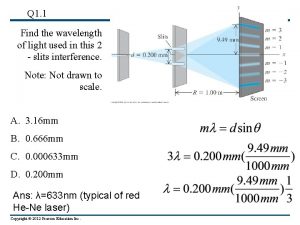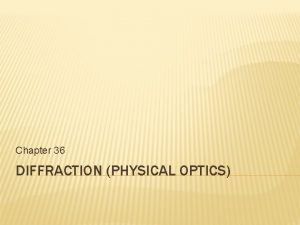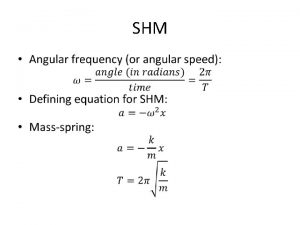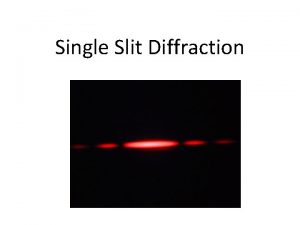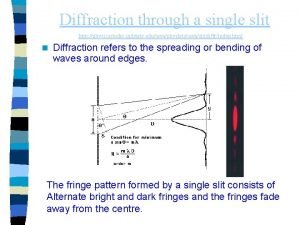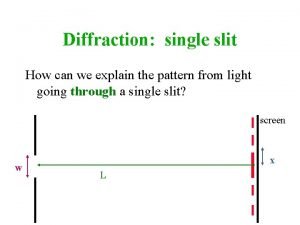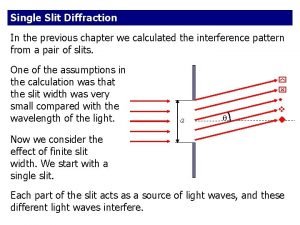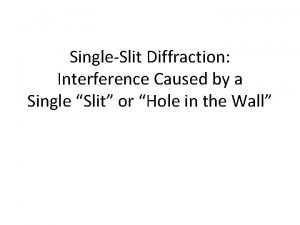Single Slit Diffraction What you need to know











- Slides: 11

Single Slit Diffraction

What you need to know… Consider a single slit of width a, wavelength λ, where a < λ. The slit can be considered as a collection of point sources, or multiple new slits, throughout the width of the slit.

Cont’d For our purposes, we will let T represent the angle between the wave ray to a point on the screen and the normal line between the slit and the screen, and let L be the distance between the slit and the screen.

Cont’d Experimental slits that have been set up that satisfy the condition a < λ produce patterns like the one we see here. So how does a single slit produce both destructive and constructive interference?

Analysis To start, recall that we are treating each point within the aperture as a single point source (Huygens’ wavelet) from which new waves spread out. We need to do this in order to compare the path differences of the individual wavelets.

Analysis Cont’d Consider the diagram to left. Recall double slit interference. As already discussed, the path difference between the 2 point sources is given by a*sin (T) The diagram on the left is a depiction of what happens when T = 0, which is consistent with our experimental observations i. e. Central Maximum in the centre.

Analysis Cont’d Now, our observations tell us that as T varies greater than zero, the central maximum drops in intensity. Then, when a*sin (T) = λ, the point source at the very bottom of the aperture and the first one at top will be in phase.

Analysis Cont’d However, if the waves are in phase, that means that the path difference between the point 1 st point source right beneath the top point source and the first point source right beneath the middle point source is λ/2. That is, they are out of phase, and therefore interfere destructively. This pattern will continue – Assume that there are 2 k sources. The source located at position 1 cancels with the source located at position k+1, etc, until k cancels with 2 k.

Analysis Cont’d Mathematically, we can define this result as sin (T) = nλ / a where n = 1, 2, 3, … For constructive interference, waves will begin to interfere constructively again once all waves that have a phase difference of λ/2 have cancelled. That is, once the path difference between the very top point source is a multiple of 3λ/2. This is a result of the fact that all waves produced between positions 1 and 2 k (found in 2/3’s of the slit) have cancelled, leaving the point sources in the top 1/3 nearly in phase and able to interfere constructively.

Final Analysis and Conclusions Mathematically, we can state this as sin (T) = (m + ½) λ / a m = 1, 2, 3, … So, as we can see, double slit interference had the opposite conditions for interference patterns. That’s because double slit interference patters really are just a special case of a more general, multiple slit, scenario.

Final Analysis and Conclusions Cont’d Another conclusion we can draw from the above results is the locations of the dark and bright fringes, respectively. We have yn / L = nλ / a (minima) and ym / L = (m + ½) λ / a (maxima) and because we can use our small angle approximation once again, we know that the widths of both dark and bright fringes are given by ∆y / L = λ / a
 Double slit vs single slit
Double slit vs single slit Double slit diffraction
Double slit diffraction Slit diffraction
Slit diffraction Slit diffraction
Slit diffraction For viewing tiny objects in a microscope diffraction is
For viewing tiny objects in a microscope diffraction is Slit diffraction
Slit diffraction Vertical wave
Vertical wave Single slit envelope
Single slit envelope Http //www.phys.hawaii.edu/ teb/optics/java/slitdiffr/
Http //www.phys.hawaii.edu/ teb/optics/java/slitdiffr/ Single slit envelope
Single slit envelope Everything you need to know about the odyssey
Everything you need to know about the odyssey Fresnel and fraunhofer diffraction difference
Fresnel and fraunhofer diffraction difference
